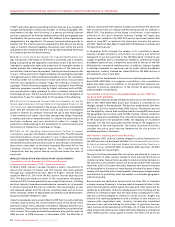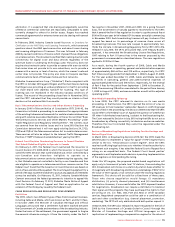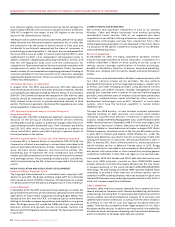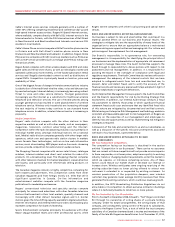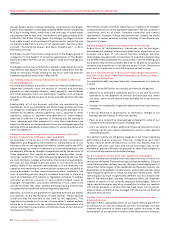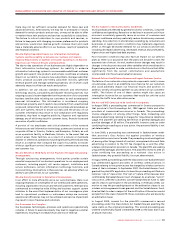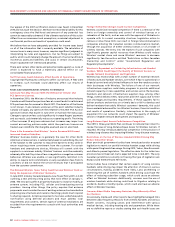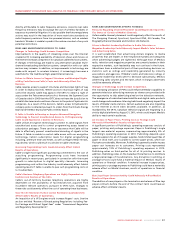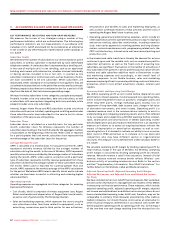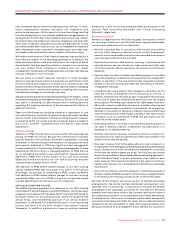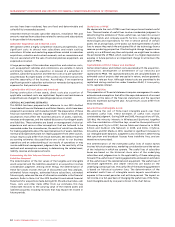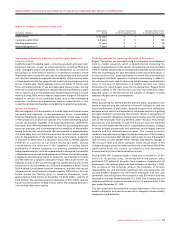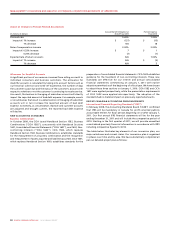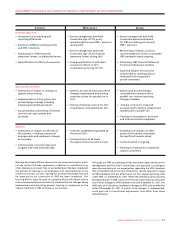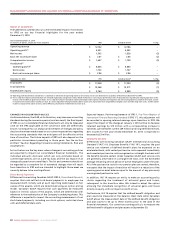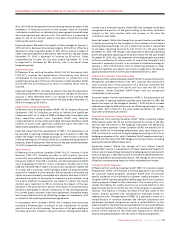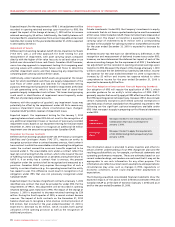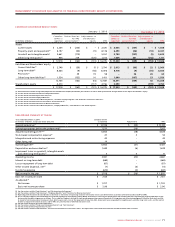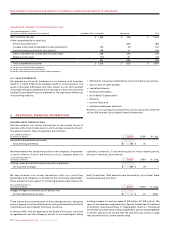Rogers 2010 Annual Report Download - page 59
Download and view the complete annual report
Please find page 59 of the 2010 Rogers annual report below. You can navigate through the pages in the report by either clicking on the pages listed below, or by using the keyword search tool below to find specific information within the annual report.
ROGERS COMMUNICATIONS INC. 2010 ANNUAL REPORT 63
MANAGEMENT’S DISCUSSION AND ANALYSIS OF FINANCIAL CONDITION AND RESULTS OF OPERATIONS
cash-settlement feature related to employee stock options; (ii) stock-
based compensation expense (recovery); (iii) integration and
restructuring expenses; (iv) the impact of a one-time charge resulting
from the renegotiation of an Internet-related services agreement; (v)
an adjustment for CRTC Part II fees related to prior periods; (vi) contract
termination fees; (vii) settlement of pension obligations; and (viii) other
items (net). In addition, adjusted net income and adjusted net income
per share excludes debt issuance costs, loss on repayment of long-term
debt, impairment losses on goodwill, intangible assets and other long-
term assets, and the related income tax impacts of the above items.
We believe that these non-GAAP financial measures may provide for a
more effective analysis of our operating performance. In addition, the
items mentioned above could potentially distort the analysis of trends
due to the fact that they are either volatile or unusual or non-recurring,
can vary widely from company-to-company and can impair
comparability. The exclusion of these items does not mean that they are
unusual, infrequent or non-recurring.
We use these non-GAAP measures internally to make strategic
decisions, forecast future results and evaluate our performance from
period-to-period and compare to forecasts on a consistent basis. We
believe that these measures present trends that are useful in managing
the business, and to investors and analysts in enabling them to assess
the underlying changes in our business over time.
Adjusted operating profit and adjusted operating profit margins, which
are reviewed regularly by management and our Board of Directors, are
also useful in assessing our performance and in making decisions
regarding the ongoing operations of the business and the ability to
generate cash flows.
These non-GAAP measures should be viewed as a supplement to, and
not a substitute for, our results of operations reported under Canadian
and U.S. GAAP. A reconciliation of these non-GAAP financial measures
to operating profit, net income and net income per share is included in
the section entitled “Supplementary Information: Non-GAAP
Calculations”.
Additions to PP&E
Additions to PP&E include those costs associated with acquiring and
placing our PP&E into service. Because the communications business
requires extensive and continual investment in equipment, including
investment in new technologies and expansion of geographical reach
and capacity, additions to PP&E are significant and management
focuses continually on the planning, funding and management of these
expenditures. We focus more on managing additions to PP&E than we
do on managing depreciation and amortization expense because
additions to PP&E have a direct impact on our cash flow, whereas
depreciation and amortization are non-cash accounting measures
required under Canadian and U.S. GAAP.
The additions to PP&E before related changes to non-cash working
capital represent PP&E that we actually took title to in the period.
Accordingly, for purposes of comparing our PP&E outlays, we believe
that additions to PP&E before related changes to non-cash working
capital best reflect our cost of PP&E in a period, and provide a more
accurate determination for period-to-period comparisons.
CRITICAL ACCOUNTING POLICIES
This MD&A has been prepared with reference to our 2010 Audited
Consolidated Financial Statements and Notes thereto, which have been
prepared in accordance with Canadian GAAP. The Audit Committee of
the Board reviews our accounting policies, reviews all quarterly and
annual filings, and recommends approval of our annual financial
statements to the Board. For a detailed discussion of our accounting
policies, see Note 2 to the 2010 Audited Consolidated Financial
Statements. In addition, a discussion of new accounting standards
adopted by us and critical accounting estimates are discussed in the
sections “New Accounting Standards” and “Critical Accounting
Estimates”, respectively.
Revenue Recognition
Revenue is categorized into the following types, the majority of which
are recurring in nature on a monthly basis from ongoing relationships,
contractual or otherwise, with our subscribers:
• Monthlysubscriberfeesin connection withwirelessandwireline
services, cable, telephony, Internet services, rental of equipment,
network services and media subscriptions are recorded as revenue on
a pro rata basis as the service is provided;
• Revenuefromairtime,dataservices,roaming,long-distanceand
optional services, pay-per-use services, video rentals and other sales
of products are recorded as revenue as the services or products are
delivered;
• Revenuefromthesaleofwirelessandcableequipmentisrecorded
when the equipment is delivered and accepted by the independent
dealer or subscriber in the case of direct sales. Equipment subsidies
related to new and existing subscribers are recorded as a reduction
of equipment revenues;
• Installationfeesandactivationfeeschargedtosubscribersdonot
meet the criteria as a separate unit of accounting. As a result, in
Wireless, these fees are recorded as part of equipment revenue and,
in the case of Cable, are deferred and amortized over the related
service period. The related service period for Cable ranges from 26 to
48 months, based on subscriber disconnects, transfers of service and
moves. Incremental direct installation costs related to re-connects are
deferred to the extent of deferred installation fees and amortized
over the same period as these related installation fees. New connect
installation costs are capitalized to PP&E and amortized over the
useful life of the related assets;
• Advertisingrevenueisrecordedintheperiodtheadvertisingairson
our radio or television stations, is featured in our publications, or is
displayed on our digital properties;
• Monthlysubscriptionrevenuesreceivedbytelevisionstationsfor
subscriptions from cable and satellite providers are recorded in the
month in which they are earned;
• BlueJays’revenuefromhomegameadmissionandconcessionsis
recognized as the related games are played during the baseball regular
season. Revenue from radio and television agreements is recorded
at the time the related games are aired. The Blue Jays also receive
revenue from the Major League Baseball Revenue Sharing Agreement,
which distributes funds to and from member clubs, based on each
club’s revenues. This revenue is recognized in the season in which it is
earned, when the amount is estimable and collectibility is reasonably
assured; and
• Discountsprovidedtocustomersrelatedtocombinedpurchasesof
Wireless, Cable and Media products and services are charged directly
to the revenue for the products and services to which they relate.
We offer certain products and services as part of multiple deliverable
arrangements. We divide multiple deliverable arrangements into
separate units of accounting. Components of multiple deliverable
arrangements are separately accounted for provided the delivered
elements have stand-alone value to the customers and the fair value of
any undelivered elements can be objectively and reliably determined.
Consideration for these units is measured and allocated amongst the
accounting units based upon their fair values and our relevant revenue
recognition policies are applied to them. We recognize revenue once
persuasive evidence of an arrangement exists, delivery has occurred or



